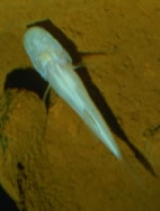
Alabama cavefish
Encyclopedia
The Alabama cavefish, Speoplatyrhinus poulsoni, is a critically endangered type of cavefish
which lives in underground pools in Key Cave, located in northwestern Alabama
, United States
in the Key Cave National Wildlife Refuge
. This is the only known location of the fish, and was discovered underneath a colony of Gray Bats in 1974 by Cooper and Kuehne.
Only nine specimens of the cavefish have been observed and scientists estimate that less than 100 are left on the planet. It is believed that this fish is the rarest of American cavefish and one of the rarest of all freshwater fish. It is the most specialized cavefish known, and exists in a fragile ecosystem based on nutrient rich guano
of the gray bat
. Researchers have failed to find the fish living in any other location.
The Alabama cavefish is a typical troglobite
.
s, isopods, amphipods, and other fish is supported by the nutrient-filled bat guano. It can also survive off of other small organisms such as mites, spiders, beetles, millipedes, and other insects. Its longevity ranges from 5 to 10 years, but it reproduces slower than all other cave dwellers. It is believed that they may reproduce like Northern Cavefish
, by carrying its young inside its mouth to be incubated. Since its reproductive cycle appears to be based on various environmental triggers, it does not reproduce every year. Its reproduction could be caused by seasonal flooding in the cave, which causes hormonal changes in the species. Because its known range is limited to a single cave, the Alabama cavefish has an uncertain future, being threatened by changes in groundwater quality and level, changes in aquifer characteristics, diminished organic input. It also may compete with the syntopic southern cavefish, Typhlichthys subterraneus
.
Cavefish
The Amblyopsidae, are commonly named: cavefish, blindfish, swampfish, etc. They are small cyprinodont freshwater fishes found in swamps, caves and some deep lakes, adapted to life in the dark...
which lives in underground pools in Key Cave, located in northwestern Alabama
Alabama
Alabama is a state located in the southeastern region of the United States. It is bordered by Tennessee to the north, Georgia to the east, Florida and the Gulf of Mexico to the south, and Mississippi to the west. Alabama ranks 30th in total land area and ranks second in the size of its inland...
, United States
United States
The United States of America is a federal constitutional republic comprising fifty states and a federal district...
in the Key Cave National Wildlife Refuge
Key Cave National Wildlife Refuge
Key Cave National Wildlife Refuge is a 1,060 acre National Wildlife Refuge located in northwestern Alabama, along the Tennessee River downstream from Florence, Alabama. Additional purchases are under negotiation which will increase the size of the refuge to 1,800 acres .More than 6,000 visitors...
. This is the only known location of the fish, and was discovered underneath a colony of Gray Bats in 1974 by Cooper and Kuehne.
Only nine specimens of the cavefish have been observed and scientists estimate that less than 100 are left on the planet. It is believed that this fish is the rarest of American cavefish and one of the rarest of all freshwater fish. It is the most specialized cavefish known, and exists in a fragile ecosystem based on nutrient rich guano
Guano
Guano is the excrement of seabirds, cave dwelling bats, and seals. Guano manure is an effective fertilizer due to its high levels of phosphorus and nitrogen and also its lack of odor. It was an important source of nitrates for gunpowder...
of the gray bat
Gray Bat
Myotis grisescens once flourished in caves all over the southeastern United States, but due to human disturbance, Gray Bat populations declined severely during the early and mid portion of the 20th century. At one cave alone, the Georgetown Cave in Northwestern Alabama, populations declined from...
. Researchers have failed to find the fish living in any other location.
The Alabama cavefish is a typical troglobite
Troglobite
Troglobites are small cave-dwelling animals that have adapted to their dark surroundings. Troglobite species include spiders, insects, fish and others. They live permanently underground and cannot survive outside the cave environment. Troglobite adaptations and characteristics include a heightened...
.
Habitat and biology
Its diet of copepodCopepod
Copepods are a group of small crustaceans found in the sea and nearly every freshwater habitat. Some species are planktonic , some are benthic , and some continental species may live in limno-terrestrial habitats and other wet terrestrial places, such as swamps, under leaf fall in wet forests,...
s, isopods, amphipods, and other fish is supported by the nutrient-filled bat guano. It can also survive off of other small organisms such as mites, spiders, beetles, millipedes, and other insects. Its longevity ranges from 5 to 10 years, but it reproduces slower than all other cave dwellers. It is believed that they may reproduce like Northern Cavefish
Northern Cavefish
Amblyopsis spelaea, The northern cavefish, northern blindfish, or blind cavefish of the mammoth cave is found in caves through Kentucky and southern Indiana...
, by carrying its young inside its mouth to be incubated. Since its reproductive cycle appears to be based on various environmental triggers, it does not reproduce every year. Its reproduction could be caused by seasonal flooding in the cave, which causes hormonal changes in the species. Because its known range is limited to a single cave, the Alabama cavefish has an uncertain future, being threatened by changes in groundwater quality and level, changes in aquifer characteristics, diminished organic input. It also may compete with the syntopic southern cavefish, Typhlichthys subterraneus
Typhlichthys subterraneus
Typhlichthys subterraneus is a species of fish in the Amblyopsidae family. It is endemic to karst regions of the eastern United States.-Taxonomy:...
.

